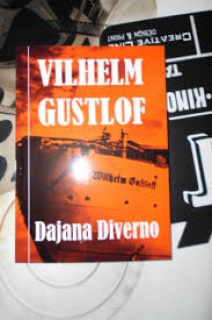20
utorak
listopad
2020
BALTIC, BLUE TOMB
The number of victims of maritime tragedies during historical memory cannot even be assumed.The two catastrophes that marked the twentieth century, each in its own way, are undoubtedly "Titanic" and "Wilhelm Gustloff".
The first as a work of economic power and technological expansion of the coming epoch. The second flagship of Hitler's war machine flotilla near the end of the most cruel and morbid human phenomenon in its existence, which was called the Second World War.
The available historical material is undoubtedly the fundamental starting point of Dianna Diverno for the idea of this novel, which will intertwine with the magic of imagination to the limits of realistic events, pointing to a number of aspects from which this very exciting dramatic reading can be viewed and interpreted.
The dispatch sent to the captain of the S-13 submarine cruising the Baltic waters, the contents of which reveal an unconditional command to completely destroy the ship and everything German, is almost identical to the Führer's order to destroy Russia completely, contained in the secret plan of "Barbarossa".
The colonies of Prur refugees who seemingly find salvation on the future "death ship" that will represent a mass grave at the bottom of the Baltic, are again reminiscent of mass, land-based execution sites across Russia in the operations of the infernal plan "Blickring 1941"
This boomerang of Nazism, guided through Dianna's literal prism that brings mutual innocent victims and destruction of material goods, brings the highest honors for merit to both sides, reflected in the absurdity of war.
The peculiarity of the novel "Wilhelm Gustloff", I would say from the margins of the historical framework that should be respected, is the "conspiracy theory".
Namely, by linking the sinking of the Titanic with sabotage for the higher interests of imperialism and the banking oligarchy, the writer casts a shadow of doubt on the similarity of the tragic fate of this ship, its main "hero" of the novel, on whose decks, corridors, salons, The most extensive and most significant part of the action takes place in the rooms until the collision with the "iceberg" and the final "anchorage".
Sisters Ursel and Uma come to Norway, find a home, start a new life. Ursula by marriage, and Uma by giving birth to a newborn born from a not very romantic relationship on a ship, but she will have great affection for the delivery of a will and grateful material support to raise her child who will bear the name "Wilhelm" as permanent. the memory of the ship of the same name and Norman as the victim of a contract killer.
This extraordinarily shaped historical story is colored by the crime genre, which in truth is not typical of what happens on a ship, but in the whirlwind of war and imagination of a writer like Dianna Diverno, everything is expected. That is why the reader, I am convinced, expects an exciting conviction that he is a participant in the suffering corps who will happily survive the sinking of "Wilhelm Gustloff" while the victims of "Baltic, Blue Tombs" will be kept in peace while memory lasts.
Subotica, June 24, 2012
Filip Orovicki
komentiraj (0) * ispiši * #

